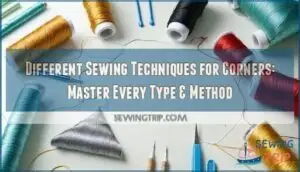This site is supported by our readers. We may earn a commission, at no cost to you, if you purchase through links.

Each technique demands specific fabric handling—trim excess before turning, pivot precisely at corner points, and press seams flat.
Sharp points emerge when you use pointed tools like chopsticks or seam rippers to push corners out completely.
Your fabric choice affects technique selection, while proper measuring prevents puckering.
From basic square corners to advanced yoke and lapel corners, each method serves different project needs.
The secret lies in matching your corner technique to your fabric weight and project requirements, using the right tools for the job, such as seam rippers, and understanding how to handle different types of corners, including outward right-angled corners and inward corners, to achieve the desired outcome with proper measuring.
Table Of Contents
Key Takeaways
- Match your corner technique to your fabric weight and project needs – you’ll get cleaner results when you choose outward corners for pillowcases, inward corners for necklines, and mitered corners for decorative edges like napkins.
- Master the essential trimming and pivoting sequence – you should trim seam allowances to 1/8 inch, keep your needle down when pivoting, and use a pointed tool like a chopstick to push out sharp corners without damaging fabric.
- Practice proper pressing and seam preparation – you’ll achieve professional results by pressing seams flat while warm, grading different fabric layers, and testing your techniques on scraps before working on your actual project.
- Use specialized tools for different corner challenges – you can create crisp points with corner turners, maintain consistent measurements with seam guides, and prevent fraying by backstitching at stress points for durability.
Sewing Corner Types
Mastering different corner types transforms your sewing from amateur to professional, giving you the skills to tackle any project with confidence.
Each corner technique serves specific purposes, from sharp collar points to dimensional tote bags, and choosing the right method guarantees your finished pieces look polished and well-constructed.
Corner types transforms your sewing from amateur to professional, giving you the skills to tackle any project with confidence.
Outward Right-Angled Corners
You’ll tackle outward right-angled corners when crafting pillowcase corners and pouch construction projects.
These 90-degree angles form the backbone of rectangular items, demanding precise seam reinforcement for corner durability.
Master these fundamental outward corners by trimming fabric to reduce bulk, pivoting carefully at the corner point, and pressing thoroughly.
These sewing techniques create clean, professional results in your corner work.
Inward Corners
Inward corners appear where fabric turns inward at 90-degree angles, creating V-shaped intersections in garments like square necklines and jacket vents.
These corner techniques require precise clipping corners to the seam allowance, preventing fabric bunching at stress points.
Proper vent techniques involve cutting diagonally toward the corner point without cutting through your seam line, and square finishes depend on accurate neckline angles and careful handling of these delicate areas during construction, ensuring a smooth and professional result with precise clipping.
Narrow Pointed Corners
Narrow pointed corners demand precision for achieving razor-sharp results on collar points, scrunchie bows, and tie belts.
You’ll need interfacing usage for structure and a corner turner or point turner to push out those sharp points without damaging fabric.
Trim seam allowances to 1/8 inch, then carefully work the point outward using your specialized tool for maximum corner sharpness.
Boxed Corners
Boxed corners transform flat fabric into three-dimensional shapes, perfect for tote bags and storage containers.
Start with fabric inside out, pulling apart seams to create triangle formation. Measure your desired box depth from the seam tip, then draw a perpendicular line.
Sew across this line with backstitching support for durability. Trim excess fabric, leaving quarter-inch seam allowance for bulk reduction. This corner shaping technique provides structural integrity through proper fabric manipulation.
Mitered Corners
Mitered corners create polished, flat-lying edges perfect for napkins, blankets, and quilts.
These decorative corners join fabric at a 45-degree angle, distributing tension evenly across the seam.
- Angle Accuracy – Mark precise 45-degree diagonal lines
- Double Hemming – Fold fabric edges twice before mitering
- Bulk Reduction – Trim excess fabric after stitching
- Tension Distribution – Press thoroughly for professional results
Corner Sewing Techniques
Mastering corner sewing techniques transforms your projects from amateur to professional quality. You’ll need to understand trimming, pivoting, pressing, and using guides to create perfect corners every time.
Trimming Excess Fabric
You’ll want to trim excess fabric to about 1/8" from your seam line after sewing corners.
This reduces bulk and prevents fabric from bunching up when you turn your project right side out.
| Trimming Method | Best For | Key Benefit |
|---|---|---|
| Reducing Bulk | Thick fabrics, multiple layers | Eliminates excess material |
| Grading Seams | Layered corners with different lengths | Prevents sharp edges showing |
| Angle Trimming | Sharp points, collar tips | Creates crisp corner definition |
Proper trimming transforms bulky, awkward corners into clean, professional-looking results that lay flat and maintain their shape.
Pivoting at Corners
After trimming, position your needle down at the pivot point before lifting the presser foot.
This needle position locks your stitching line while you rotate the fabric.
Turn your project smoothly, aligning the next edge with your seam allowance guide.
Lower the presser foot and continue sewing.
This pivoting technique prevents gaps and maintains consistent seam width throughout corner construction.
Pressing Seams
After sewing corners, proper pressing transforms your work from amateur to professional.
Use seam pressing tools like a pressing ham or point presser for precision. Temperature control matters—test your iron on fabric scraps first.
Different fabric types need different heat settings to prevent shine or damage. Press seam allowances open or to one side, depending on your project.
Understanding when to press seams open can reduce bulk. The right pressing techniques smooth out wrinkles and set your corner seams permanently, making your work look professional with proper pressing.
Using Seam Guides
After pressing your seams, seam guides become your best friend for maintaining accuracy. These simple tools help you stop at precise points and pivot fabric correctly, ensuring consistent seam allowance throughout your project.
Many sewers find that sewing seam guides improve accuracy.
- Custom guides – Create magnetic guides or tape markers for repeated measurements
- Guide alternatives – Use your needle plate markings or quilting rulers as reference points
- Consistent seams – Mark your stopping point before you start sewing corners
- Guide accuracy – Test your setup on scraps to verify measurements match your pattern requirements
Sewing Sharp Points
Sharp corners don’t happen by accident—they require the right tools and techniques to transform your fabric from floppy to professional.
You’ll master three essential methods: using pointed tools to push out corners, proper pushing techniques that won’t damage your fabric, and finishing steps that create crisp, lasting points.
The goal is to create crisp, lasting points with these techniques, ensuring your fabric looks professional.
Using Pointed Tools
Several tool materials work perfectly for turning corners without damaging fabric.
Sharpen dowels with a pencil sharpener to create safe, dull points for pushing out corners.
File bamboo skewers flat to eliminate sharp edges.
Avoid using scissors or other sharp implements that can tear delicate fabrics.
A proper corner turner or point turner gives you precise control when perfecting those crisp corner techniques.
For marking fabric, consider using fabric marking pens for precision.
This is especially useful when you need to make crisp corner techniques or delicate fabrics.
Pushing Out Corners
Proper corner pushing separates novice work from professional results.
You’ll need the right tool alternatives to achieve sharp points without fabric damage.
A blunt dowel works better than scissors for corner crispness and pointed tool safety.
For specialized projects, consider dowel options for corners.
- Dowel sharpening: Use a pencil sharpener to create a dull point that won’t tear delicate fabrics
- Tool alternatives: Try chopsticks, knitting needles, or specialty corner turners for different fabric weights
- Fabric damage prevention: Work gently from the inside, pushing gradually rather than forcing sharp points through tight spaces
Achieving Crisp Finishes
After properly pushing out corners, you’ll want to nail that perfect crisp finish.
Press seams thoroughly while fabric’s still warm for sharp corners.
Seam grading removes bulk, while understitching edges keeps seams flat.
Try corner weights for stubborn points.
Interfacing tips include pre-trimming before turning.
When clipping curves, cut close to stitching without nicking threads.
These corner techniques guarantee professional results every time.
Consider using corner weights sewing tools for precise results.
Choosing Corner Techniques
Selecting the right corner technique depends on your fabric weight, project requirements, and desired finish quality.
Consider your thread choice and take time to measure and mark accurately before you start sewing across corners for the best results.
Fabric and Thread Selection
Fabric weight impacts corner precision substantially. Medium-weight fabrics like cotton and linen provide stability, while heavy materials may create bulk at intersections.
Your thread choice should match fabric fiber content for the best results.
- Fabric Weight: Choose medium-weight materials for cleaner corner execution
- Thread Type: Match polyester thread with synthetic fabrics, cotton with natural fibers
- Color Matching: Select thread that blends seamlessly with your fabric selection
Pattern suitability depends on these factors working together for successful sewing techniques for corners.
Measuring and Marking
Accurate measuring and marking form the foundation of professional corner sewing.
Use a quilting ruler for precise angles and consistent seam allowances.
Mark fabric with disappearing ink or tailor’s chalk, guaranteeing pattern adjustments align perfectly.
Double-check measurements before cutting—ruler accuracy prevents costly mistakes.
Proper marking tools create reference points for angle precision, leading to consistent seams throughout your project.
Mastering these steps guarantees perfect corner results, such as sharp points and achieving perfect alignment with precise techniques.
Sewing Across Corners
Sometimes you need to stitch across corners instead of pivoting to accommodate seam allowances.
This technique works well with thicker fabrics where diagonal stitching prevents bulk buildup.
Mark your stitch placement carefully, ensuring corner stability through proper seam allowance management.
Test different corner techniques on scraps first – fabric thickness affects how these sewing techniques perform, so accurate sewing requires adjusting your approach to achieve corner stability.
Advanced Corner Methods
Once you’ve mastered basic corner techniques, you’ll want to tackle more complex situations that require specialized approaches.
These advanced methods handle challenging scenarios like curved seams, structural joins, and decorative elements that standard corner techniques can’t address effectively, involving complete concepts.
Yoke Corners
When tackling yoke construction, you’ll master one of sewing’s most professional techniques.
These structured shoulder pieces demand precision in fabric grain alignment and interfacing choice for proper drape and support.
Essential yoke corner techniques include:
- Burrito method – Encloses all seam allowances in one operation, creating clean finishes without bulk
- Corner reinforcement – Use staystitching and fabric triangles to prevent stretching and maintain sharp angles
- Topstitching options – Secure edges with consistent ⅛-inch stitching for durability and professional appearance.
Accurate sewing requires careful marking and alignment of notches before assembly.
The burrito method technique guarantees a clean finish by enclosing seams between yokes.
Curved Corners
Sewing curves requires patience and precision to achieve smooth, professional results.
Start by marking curved corners with templates or rulers for accuracy.
Use shorter stitches (1.5-2.5mm) when following curved seams, as this gives better control.
Clip curves every quarter-inch into the seam allowance, stopping just short of your stitch line.
This prevents puckering and allows the fabric to lay flat.
Grade seams by trimming layers to different lengths, reducing bulk.
For tight curves, consider bias binding since it stretches naturally around corners.
Mastering curves involves understanding the difference between concave and convex curves.
Lapel Corners
Lapel construction demands precision at every corner turn. Professional tailors know that lapel corners separate amateur work from expert craftsmanship.
These collar points require specific attention to seam allowance, fabric choice, and pressing techniques to achieve sharp, polished results.
Master lapel corners with these essential steps:
- Reduce stitch length to 15-20 stitches per inch at corner points
- Grade seam allowances by trimming undercollar to ¼" and upper collar to ⅜"
- Clip diagonally about 2mm from corner points to eliminate bulk
- Press before turning using a point presser for crisp edges
- Understitch seams to prevent rolling and maintain sharp definition
Interfacing importance can’t be overstated—it provides structure and helps maintain corner angles through repeated wear.
Mitered Joins
Mitered joins create professional 45-degree corners where fabric edges meet seamlessly. You’ll achieve superior Angle Accuracy through precise marking and careful pressing.
This technique excels in Decorative Applications like quilts and table linens, offering Bulk Reduction compared to overlapped corners. Mitered corners require precise fabric preparation for accurate results.
| Technique | Best For |
|---|---|
| Folded Miter | Narrow hems, lightweight fabrics |
| Sewn Miter | Wide borders, Double Hemming projects |
| Binding Miter | Quilt edges, curved applications |
Mitered corners distribute fabric Tension Distribution evenly, preventing puckering. Mark your seam allowance accurately, then stitch along the diagonal crease.
This sewing tutorial approach transforms ordinary sewing corners into polished, geometric perfection that elevates any project’s appearance.
Mastering Corner Sewing
Perfect corner sewing takes practice, patience, and the right approach for each project.
You’ll transform from struggling with puckered corners to creating crisp, professional-looking seams that make your handmade items look store-bought.
Practicing on Scraps
Mastering sewing corners starts with smart practice sessions using fabric scraps. This technique experimentation lets you test different approaches without wasting good material or risking project failure.
- Try various fabric weights – Practice cornering confidence on cotton, denim, and silk scraps
- Test thread tension settings – Adjust machine settings to prevent puckering at corner points
- Experiment with stitch settings – Find ideal stitch length for clean, sharp corners
- Practice common mistakes – Intentionally create errors to learn quick fixes
- Build fabric variety skills – Work with different textures to expand your sewing tutorial knowledge
Adjusting Stitch Length
After practicing on scraps, you’ll need to adjust your sewing machine’s stitch length based on fabric thickness.
Thicker materials require longer stitches to prevent puckering and maintain seam strength.
For lightweight fabrics, shorter stitches create better stitch density and corner sharpness.
Test different settings on your seam allowance samples – this fine-tuning makes the difference between amateur and professional-looking sewing corners.
Using Specialized Notions
When selecting sewing notions for corners, you’ll find specialized tools make all the difference.
Corner turner types include blunt-ended point turners and sharp corner turners for different fabric weights.
Dowel sharpening with a pencil sharpener creates perfect corner-pushing tools, while bamboo skewer filing produces safer alternatives.
Seam guide uses include maintaining consistent corner measurements, and effective pinning techniques secure layers before stitching, preventing shifting that compromises corner quality, which is why using the right tools is crucial for achieving perfect corner results.
Achieving Professional Results
Achieving professional-looking corners requires consistent practice and attention to detail. Focus on maintaining consistent seams throughout your project, ensuring each corner receives the same careful treatment.
Check your seam allowance regularly and keep accurate angles by measuring twice before cutting. When working with curves, take time to create smooth curves rather than rushing through difficult sections.
Always press each corner thoroughly to set crisp points and create that coveted professional finish. This will help you achieve smooth curves and ensure your project looks polished and well-made.
Frequently Asked Questions (FAQs)
What are the different types of corners in sewing?
Corners in sewing come in all shapes—outward right-angled, inward, narrow pointed, boxed, mitered, acute, obtuse, and rounded.
Each type helps you create sharp pillowcases, crisp collars, or elegant napkins with precision.
What is a technique used for sewing corners?
To sew perfect corners, keep your needle down when pivoting,
trim seam allowances to 1/8 inch, and use a pointed tool to gently push out sharp points after turning the fabric right side out.
This sentence is already quite clear and does not need further separation for readability.
How to sew a crisp corner?
Like transforming rough diamond into polished gem, creating crisp corners requires precise trimming, strategic pivoting, and careful pressing.
Trim seam allowances to 1/8", keep your needle down when pivoting, then use a point turner to achieve sharp, professional results, and follow these steps to get sharp corners.
How to sew good corners?
You’ll achieve sharp, professional corners by trimming seam allowances to 1/8 inch, keeping your needle down while pivoting, and using a pointed tool to gently push out corners after turning.
How do you fix puckered corners after sewing?
Fix puckered corners by trimming seam allowances to 1/8" from the stitching line, pressing seams flat, and gently pushing out points with a blunt tool like a chopstick or corner turner.
What causes corners to fray during washing?
Insufficient seam allowances, loose weave fabrics, and inadequate edge finishing cause fraying.
You’re not reinforcing stress points properly, using compatible thread weights.
You’re also not applying appropriate seam finishes like serging or pinking shears.
Can you sew corners without backstitching?
You can sew corners without backstitching, but it’s risky.
Your seams may come undone under stress or washing.
Backstitches anchor your work and prevent unraveling, especially for boxed corners and items that’ll get heavy use, making backstitches essential.
How do you repair torn corner seams?
Like fixing a frayed friendship, you’ll carefully remove damaged stitches, realign fabric edges, pin securely, then re-sew with reinforcement backstitches. Press flat when finished for professional results.
Whats the best interfacing for corner stability?
Medium-weight fusible interfacing works best for corner stability. Choose woven interfacing for structured projects like collars and jackets. Nonwoven interfacing suits lighter fabrics. Apply before cutting corners for maximum reinforcement.
Conclusion
Looking at mastery like building a foundation stone by stone, you’ll discover that different sewing techniques for corners become second nature with practice.
Start with basic right-angled corners, then progress to challenging mitered joins. Each technique serves specific projects—from simple hems to complex tailoring.
Remember that fabric weight determines your approach, while proper tools guarantee success.
Practice on scraps first, adjusting stitch length as needed.
Master these fundamentals, and you’ll tackle any corner with confidence, creating professional-quality results every time.
- https://www.purlsoho.com/create/sewn-mitered-corners/
- https://www.applegreencottage.com/how-to-sew-mitered-corners/
- https://sew4home.com/clipping-and-stitching-corners-correctly/
- https://www.youtube.com/watch?v=X75A92K5QFw
- https://blog.closetcorepatterns.com/sewing-super-sharp-collar-points-kalle-sewalong/
















